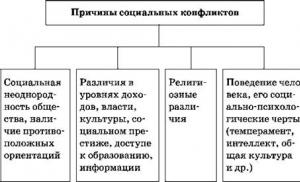Propaganda - concept, theory, goals, technology. Manipulating public opinion
Members of modern society are practically devoid of dialogue with each other; communication is replaced by the mass media. The media, and to a greater extent television, personify the communication process, thereby increasing confidence and loyalty to oneself. The main goal of media owners is to change values, perception of reality and interpretation of events, and as a result, the behavior of society in a direction that is beneficial for them. To achieve this goal, various manipulative technologies are used, which are present in absolutely all media channels. Today, in spite of their duty to reflect public opinion, the media create it.
The problem is that most of the population has no idea about the essence and methods of manipulating public opinion, as a result of which it is easily influenced.
The knowledge gained as a result of writing this work can
apply in daily practice by researching materials and programs
various media for the use of manipulative techniques, as well as protecting oneself from the effects of manipulation.
Research on "manipulating public opinion in the media" can be found in the works of S.G. Kara Murza "Manipulation of Consciousness", E.L. Dotsenko "Psychology of manipulation", G. Schiller "Manipulators of consciousness", L.I. Ryumshina "Manipulative Techniques in Advertising", I.M. Dzyaloshinsky "Manipulative technologies in mass media", A. Karpova
"Manipulative PR technologies" from other authors. Although works,
there are enough devoted to the problem of manipulation, they are united by the fact that, firstly, the authors limit themselves to listing existing manipulative techniques without classifying them, and secondly, the authors do not reflect the relationship between the features of various media channels and the specifics of the use of manipulative techniques on them.
The purpose of the course work is to analyze modern manipulative technologies, as well as their essence and application in the media.
This goal can be achieved by solving the complex
private tasks:
1. to analyze the concept of manipulation as a phenomenon in general and as a process of influencing public opinion;
2. determine what manipulative technologies are used in the media, and consider the mechanisms of their action;
3. to consider the use of manipulative technologies on each media channel separately, focusing on television, depending on their specifics;
4. to consider methods of protection against manipulation of public opinion.
The object of the course work is research and public opinion.
The subject of the research is the impact of the media (television, radio, press) on public opinion.
Research methods. In the course work, a theoretical analysis and generalization of socio-psychological literature are applied.
Based on all this, we can conclude that the problem of manipulating public opinion in the media has been sufficiently studied in the sphere of the existing arsenal of manipulative techniques, but not in the sphere of their classification and use in each of the types of media separately.
Chapter 1. Manipulative technologies in the arsenal of modern media
1.1 Manipulation as a way to influence public opinion
A huge flood is currently being poured into society.information. We are forced to make many decisions every day. However, in most cases, people do not reflect on the nature of their decisions and actions, being confident that they are based on their own desires and beliefs. Any information influencing a person can create a socio-psychological attitude in him, i.e. internal readiness for any action. This feature of the human psyche is used to manipulate public opinion. Manipulation is also facilitated by the fact that people are more often not inclined to analyze the information they receive, because it is much easier to accept it without question.
The manipulation of public consciousness can be viewed as a complexly organized manipulative activity, as a rule, of a group of people (governments, parties, etc.) or individuals (oligarchs, leaders of political movements). This activity is deliberate and purposeful, its organizers have certain goals, intentions to obtain beneficial results for themselves (for example, to induce a person to perform certain actions).
"The manipulations of public consciousness have been poorly studied, despite the fact that mention of them can be found even in Plato (" State ") and Machiavelli (" Sovereign ")."
The word "manipulation" comes from the Latin language manus - hand (manipulus - a handful, a handful, from manus and ple - to fill). In the dictionaries of European languages, manipulation is interpreted as an appeal
with objects with specific intentions, goals (for example, manual
control).
The Oxford English Dictionary treats manipulation as "the act of influencing or manipulating people with dexterity, especially with a disparaging connotation, as covert manipulation or manipulation." This means that dexterity and dexterity are required for such actions. According to S.G. Kara Murza, from understanding manipulation in the technical sense (manipulators are devices for controlling mechanisms), the modern figurative meaning of the word came about - deft treatment of people as objects, things. S.G. Kara Murza identifies the following generic signs of manipulation:
1) manipulation is a type of spiritual, psychological impact. The target of the manipulator is the spirit, mental structures
human personality;
2) manipulation is a hidden influence, the fact of which should not
be detected by the object of manipulation. As G. Schiller notes, “for
to achieve success, manipulation must remain invisible. Success
manipulation is guaranteed when the manipulated person believes that everything
what happens is natural and inevitable. As it turns out, for manipulation
a false reality is required in which its presence is not
will be felt. " If an attempt at manipulation is revealed and it becomes known to a wide audience, the action is usually curtailed, since the revealed fact of the use of manipulative technologies causes significant damage to the manipulator. The purpose of the manipulation is concealed even more carefully. Sometimes, along with the concealment and concealment of information, such a method as "ultimate self-disclosure" is used, a game of sincerity, for example, when a politician wants to "pass for his own" and appear to the audience as an honest and sincere person;
3) people whose consciousness is being manipulated are not treated as individuals, but as a special kind of things. Using "living material", the manipulator achieves its goals.
So, the process of manipulating people can be explained as follows
way. It can be seen as the exploitation of people for the benefit of the manipulator. In this case, people turn into
objects of manipulation are devalued and reified. Actions,
performed on the manipulated, unknown, hidden and invisible to him.
The psychological meaning of manipulation is programming and
controlling people's behavior, gaining power or advantage over them
by limiting their freedom, choice, creating such a situation, in
which the object will behave in a way beneficial to the manipulator, not
with or without a choice.
The purpose of any manipulation is to hide their true intentions, to induce a person to perform certain actions, to change values, opinions, attitudes, perceptions and attitudes. A necessary condition is to preserve the illusion of freedom of choice of decisions, the illusion of independence in the manipulation object. In other words, to make sure that a person is sure that he acts of his own free will, that this is his own desire. For example, a customer in a store selects a well-advertised product from among other lesser-known products. This item has not previously been purchased by him. When buying, he experiences
positive emotions, a visual series pops up in his mind,
showing happy and healthy people (they are already happy from
one possession of the advertised product), short
phrases that assure the buyer of high quality and advantage
product in its class. The buyer does not even doubt that this
his own decision to purchase this product, because he chose it from
a considerable number of alternatives. But in fact, the buyer, who is
object of manipulation, does not even consider these
alternatives.
In this example, the customer was clearly focused on meeting their needs. A. Karpov writes: “The psyche“ materializes ”the human needs in the form of a set of stereotypes, attitudes,
standard rules. Assessing any external situation, a person
compares it with these stereotypes and makes a "conclusion" about how much
this or that need is satisfied. This "conclusion" is nothing
other than emotion (the word output is enclosed in quotation marks, because under it usually
understand a logical conclusion, and emotion is not a logical conclusion).
If the need is satisfied, then we do not hesitate and do not reason,
we feel a positive emotion (joy, gratitude), if not
negative (fear, anger, hatred) ". Precisely because the emotional sphere is little subject to logic (most prefer an emotional assessment of the situation to reasoning and logical conclusions), it is one of the most vulnerable targets for manipulation. To force a person to act according to the program set by the manipulator, it is necessary to evoke an emotion so strong that it overwhelms the person, does not give an opportunity to return to a rational level and calmly ponder the situation. “And if a set of stereotypes is known to the manipulator, then his task is to form (through the mechanisms of perception and imagination) such an image of reality, which will be the corresponding stereotype
"Transformed" into the desired emotion. "
You need to understand that any manipulation is interaction without
participation of the object to which it is directed, the manipulation will not take place.
Let's move on directly to manipulating public opinion. Public opinion is understood as a state of mass consciousness, which includes an attitude towards social events, towards the activities of various organizations or individuals, expresses a position of approval or condemnation on certain social problems, regulates the behavior of individuals, social groups and institutions, and imposes certain norms of social relations ...
The manipulation of public opinion can be understood as one of the methods of domination and suppression of the will of citizens through programming their behavior. This impact is directed not at individual individuals, but at society as a whole, it sets as its task to change the opinions, motives and goals of people in the direction needed by manipulators. Manipulation of public opinion can be viewed as a complex strategy of persuasion with the aim of imposing collective values and transforming the mentality of a certain group of people to maintain the power of the ruling elite, and more broadly, to “reproduce the existing status quo in the social structure. The person does not have direct contact with public opinion. People learn about its content from the media, and the rating is considered the only objective characteristic of public opinion. The picture of public opinion, created on the basis of ratings, is embedded in the consciousness of the individual, who always subconsciously identifies himself with the majority, since in the mass consciousness it is the majority that is the bearer of real truth. People are not told directly: "Act this way and not otherwise," but they find
a psychological trick that elicits an appropriate response. The point is now to distribute these "stimuli" that cause certain actions, feelings, certain mystical impulses. "
Influencing public opinion is one of the leading functions of the media. The manipulation of public opinion in most cases is based on the use of stereotypes. For successful manipulation of public opinion, it is necessary to have a reliable “map of stereotypes” of different groups and strata of the population - the entire cultural context of a given society. If it is possible to push large masses of people to see some social phenomenon through the stereotype needed by the manipulator, then
it is very difficult for those who disagree with this phenomenon to appeal to people to a healthy
meaning.
The media are most often accused of manipulating public
opinion. And there is every reason for that. According to M. Parenti, the media
“Take away most of the information and misinformation that we
we use to assess the socio-political reality. Our
attitude to problems and phenomena, even the very approach to the fact that
considered a problem or phenomenon, are largely predetermined by those who
controls the world of communications. " The media have become the main tool for manipulating public opinion. Therefore, many scientists believe that the media create a symbolic image of reality, in another way, quasi reality. The media offer us ready-made models of behavior (through serials, talk shows), provide ready-made opinions and interpretations, in fact, turning society into a mindless mass of information consumers who stop thinking and analyzing information, thereby simplifying the process of manipulation. Media limits the scope of information that must reach the audience.
In fact, what does not get into the media, as if it does not exist, we do not attach due importance to such information.
For example, television shows mainly representatives of the middle and upper strata, people with prestigious professions and high incomes. People from the lower strata are much less common. Women are portrayed as the embodiment of love passions and family relationships, not professional qualities. A significant place is occupied by the theme of violence as "the simplest and cheapest dramatic means of demonstrating the rules of the game for power."
But this often has a detrimental effect on people: they get so used to living in a virtual, symbolic world (for example, in the world of computer games) that, in contact with the real world, they can begin to kill people like enemies in the game. The media also form the internal readiness of the audience to perceive any object or episode of reality in a certain way, changing not only the consciousness of people, but also their social attitudes (the concept is associated with the significance for a person of a certain object or action, which are assessed as “good-bad”, “ useful - harmful ", etc.).
Manipulation is also used in political communication, in public speaking. In a postindustrial society, the power of information becomes decisive in the management of society, pushing into the background the influence of money and state coercion. The direct carriers and disseminators of knowledge and other politically significant information are the media. The information function is the most important function of the media. It consists in obtaining and disseminating information about the most important events for citizens and authorities. On the basis of the information received, citizens form an opinion about the activities of the government, about the economic, cultural and other life of society.
The influence on the policy of the media is carried out, first of all, through the influence on the information process, which makes it possible to form public opinion in a certain way. The main stages of the information process are the receipt, selection, dissection, commenting and dissemination of information.
The selection of the most important information and its presentation is an important task of the entire media system, which naturally opens up wide opportunities for manipulating public opinion.
Thus, the awareness of citizens, including politicians, directly depends on how, for what purposes and by what criteria the information is selected, how deeply it reflects the real facts after its dissection and reduction, carried out by the media, as well as on the method and forms of presentation. information.
Among the manipulative techniques used in political communication, the following techniques can be distinguished:
1) sticking labels. One of the most effective weapons
political language are manipulative terms, or "labels"
which are "hung" on political opponents. Their danger is
that, entering into widespread use thanks to the media, they take root for a long time,
become familiar, everyday words;
2) the technique of "creating negative associations", the task of which is to activate a negative image in a person's memory and transfer it to a specific politician. During the parliamentary campaign
The media have made extensive use of this technique. Weak, sick Primakov
(association with the times of "stagnation"); and vice versa, an active, young, promising politician Putin (associations with honesty, openness, energetic qualities that can lead the country out of the crisis, the image of a laconic but active politician);
3) the technique of "creating counter-associations" in order to associate a politician with a positive image that has developed in the mind. Primakov is a person whose advanced years are more likely to testify to a rich life and political experience, a recognized respect and an image attached to it
wise, non-conflict politician;
4) appeal to specific facts and documentation. This technique
based on the peculiarity of human psychology, which is that
a common man in the street is more inclined to believe in specific numbers and papers with a seal than in “naked” words. The analytical program of S. Dorenko (especially during the parliamentary campaign) is a vivid example of the use of this technique. Any word of the presenter was confirmed by visual evidence: individual documents and articles of laws are shown, materials previously published in the media are cited, videos are shown with explanatory comments.
So, we can conclude that manipulation is aimed at changing public opinion, and then behavior in a direction favorable to the manipulator. To achieve this task, it is necessary to evoke in the audience a certain, moreover, strong emotion; stereotypes of society are also used, which, unfortunately, are known to manipulators. In whatever area manipulation is used, its goals and techniques
remain hidden to society, a person, as an object of manipulation,
depreciates.
1.2. Manipulative techniques in the media
There are a huge number of manipulative techniques, but inin most cases they are not classified. Usually, authors limit themselves to listing a few techniques, without referring them to separate groups. After analyzing the work of S.G. KaraMurza ("Manipulation of Consciousness"), A. Karpova ("Manipulative PR Technologies"), I.M. Dzyaloshinsky ("Manipulative technologies in mass media") and G. Schiller ("Manipulators of consciousness"), the following classification can be made:
1) Manipulation of information flows. It is achieved in
first of all, by selecting events for messages. One of the mechanisms
manipulation of public opinion, which uses the media,
is to draw attention to certain problems. Only the problem that is covered by the media becomes the property of public attention. In this case, the media acts as the main "problematizer" of society. But the informational picture of the world is not always adequate to reality.
Among the methods of control over information flows, first of all
a method of fabricating facts (outright lies) or disinformation should be included. Experts believe that this technique is not used only in cases where it can be detected, while politicians and
figures in the modern press often state that the press does not use
outright lie, tk. the same effect can be achieved by dispensing truth. "When
disclosure is hampered by unavailability of information or is bypassed
too expensive, the press lies without a twinge of conscience (“in politics the word
"Truth" means any statement whose falsity cannot be
proved) ". Simple deception, being one of the important private techniques in the entire technology of manipulation, cannot by itself constitute a manipulative effect. As E.L.Dotsenko writes, “For example, someone asks us for directions to Minsk, and we send him falsely to Pinsk, this is just a deception. The manipulation will take place in the event that the other one was going to go to Minsk, and we made it so that he wanted to go to Pinsk ”. Lying can take many forms: attributing to someone or something different qualities, distorting images of actual events, exaggeration, shuffling of facts, pure fiction. According to I.M. Dzyaloshinsky, disinformation is used, as a rule, at the moment of making an important decision, and when the truth is known, the goal of disinformation will already be achieved.
One of the most important rules for manipulating consciousness is to isolate the addressee from outside influences. Manipulation is incompatible with dialogue and public debate. The ideal situation is the totality of the impact - the absence of alternative, uncontrolled
sources of information and opinions. The foundation has already been laid for this.
- The media are practically the only source of information and reference point in the world for a modern person, real interpersonal communication is gradually decreasing - it is being replaced by a TV, computer, radio. The main thing in manipulation is the creation of the addressee's illusion of independence and pluralism of information channels.
2) Selection of reality events for messages. The bulk of the media creates virtual reality. Opinions are dominated by the one who determines the structure of the information flow, selects facts and problems,
turning them into messages, in other words, forms the agenda. It's clear,
that the problems that the media cover are not always so strong
society is worried about how the impression may be formed, they may not
so important against the background of other, but no longer covered issues. So
Thus, the media do not leave room for dialogue, do not provide a variety of opinions, i.e. ensure that the basic rule for successful manipulation is fulfilled. G. Schiller writes: “Information
monopolies restrict information choices in all areas of activity. They offer only one version of reality - their
own ". There are a lot of examples of the removal of facts and problems from reality: there is practically no serious information about Asia in the Western media. From China, India and Japan, there are either exotic messages (karate, Chinese cuisine) or exciting political (terrorism, religious violence, public executions of drug traffickers). From all that has been said, we can conclude that those facts that are not beneficial and contradict the interests of the authorities make up an insignificant part of the agenda. So, by suppressing information that is unfavorable for the owners of the media, they create a "virtual" reality, or quasi reality, instead of reflecting reality.
3) The principle of noise democracy. The trick consists of drowning an unavoidable message in a messy stream of meaningless and unimportant information. G. Schiller writes: "Just as advertising interferes with concentration and deprives interrupted information of weight, the new information processing technique allows filling the airwaves with streams of useless information, further complicating the already hopeless search for thought for the individual."
4) Using rumors. Rumors mean information transmitted in interpersonal communication concerning important events in public life and reflecting the desire of people to conjecture a situation that is not clear to them. Rumors are often based on false information, rumors may be the result of a lack of information. On the one hand, they explain the situation, and on the other hand, they help people relieve emotional stress.
5) Repetition. This is the main method of fixing the necessary stereotypes in the mind. S.G. KaraMurza quotes S. Moskovichi: “Repetition is the second condition for propaganda. It gives weight to statements as additional persuasion and turns them into obsessions. Hearing them over and over again, in different versions and for very different reasons, in the end you begin to be imbued with them. " Specialists in manipulation are well aware of a simple psychological effect: an image that a person has memorized becomes "his own" for him, so the person trusts this image. It is important to remember that memory is practically not controlled by consciousness, which naturally facilitates manipulation. This method affects the subconscious of a person, prompting him to accept statements completely and unconditionally and turning them into action. A recurring thought reduces people's reasoning to a minimum and turns into evidence that does not depend on time, place and person.
6) Crushing. It consists in dividing a holistic problem into separate fragments in such a way that the reader or viewer cannot
connect and comprehend the problem. A multitude of
techniques: breaking a newspaper article into parts and premises
them on different pages, text or TV show are broken by advertisements.
G. Schiller gives the following explanation: “Whatever is said, everything
completely dissolves into subsequent advertisements, comic tricks, intimate scenes and gossip. " By tearing apart information about an important event, it is possible to reduce its effect on the masses, or even to deprive it of its meaning altogether. A kind of fragmentation is the "construction" of a message from fragments of an utterance or video sequence. At the same time, the context changes, and a completely different meaning is created from the same words.
7) The method consists in the immediacy of information, giving it character
urgency and immediacy. In the United States, the overwhelmed sense of urgency of messages is believed to create a sense of extraordinary
the importance of the subject of information. Constant updating of information deprives it of its structure and prevents a person from comprehending and understanding information, because they are replaced by even newer messages. Since a person concentrates on the events taking place at the moment, he is torn
connection with the past, and this is extremely important for removing psychological protection
from manipulation.
8) Sensationalism. The system of sensations allows you to split information so that the audience does not receive complete and holistic knowledge about the problem.
“These are reports of events that are given such high importance
and the uniqueness that concentrates on them and the right time
almost all the attention of the public is being held. " With this method, you can keep silent about events that the public should not notice. An event, in order to be selected as sensational, must contain a signal of high memorability, at least on a subconscious level. The society under the constant influence of sensations, especially those carrying negative information, reaches the level of “nervousness” necessary for the manipulator, a feeling of constant crisis and tension. Information presented on television in the form of a sensation is usually accompanied by live interviews, reports from the scene, which creates in the viewer a sense of the reliability of the information and the absence of an intermediary between them and reality. But as a rule, sensational information distorts the event that happened, and the viewer's sense of credibility is an illusion.
10) Transfer of a positive image. The essence of the method consists in the projection of the positive qualities of a person (authority, prestige), an object or
moral values (individual, group, national) for another person or group. For example, in political advertising based on the popularity of a party or a specific politician, the image of members of an electoral bloc is “promoted”.
11) Using authority. The method is to use reputable people or groups known to the target audience. There are the following criteria for selecting characters for this method: trust in a representative of the influence group, his fame, high professional qualities, personal dignity, high official position (past or present), his proximity to the target audience, etc. An authoritative person or a celebrity confirms the dignity, importance of a particular person or phenomenon, as a result of which the audience's confidence in the message increases. There is a psychological "transfer" mechanism, in which the dignity of an authoritative person is transferred to a person or phenomenon. The same as everyone else, like us or the "game of the common people." The trick is to increase the trust of the target audience, ensuring that a particular person or group is identified with it. Are used
idiomatic expressions, jokes, social and cultural characteristics characteristic of a particular audience. In election campaigns, the image of the candidate is of paramount importance, and it must correspond to the chosen target audience.
etc.................
"through the media.
1. Distraction
The main element of social management is to divert people's attention from important problems and decisions made by political and economic ruling circles through the constant saturation of the information space with insignificant messages. Distraction is essential to prevent citizens from gaining important knowledge in science, economics, psychology, neurobiology, and cybernetics.
"Constantly distract the attention of citizens from real social problems, switching it to topics that have no real meaning. To ensure that citizens are constantly busy with something and they do not have time to think; from the field to the corral, like everyone else animals (quote from the book "Silent weapons for quiet wars").
2. Create problems and then suggest solutions
This method is also called problem-response-solution. A problem is being created, a kind of "situation" calculated to evoke a certain reaction among the population so that it itself requires the adoption of measures that are necessary for the ruling circles. For example, allow urban violence to spiral or organize bloody attacks to get citizens to demand stronger security laws and policies that infringe on civil liberties.
Or: trigger an economic crisis in order to force the violation of social rights and the curtailment of the work of city services to be accepted as a necessary evil.
3. Method of gradual application
To get an unpopular measure taken, it is enough to implement it gradually, day after day, year after year. This is how fundamentally new socio-economic conditions (neoliberalism) were imposed in the 80s and 90s of the last century.
Minimizing the functions of the state, privatization, uncertainty, instability, massive unemployment, wages that no longer provide a decent life. If all this happened at the same time, it would surely lead to a revolution.
4. Postponement of execution
Another way to push through an unpopular decision is to present it as "painful and necessary" and to get the citizens' consent at the moment to implement it in the future. It is much easier to agree to any sacrifices in the future than in the present.
First, because it won't happen immediately. Secondly, because the people in their mass are always inclined to cherish naive hopes that "tomorrow everything will change for the better" and that the sacrifices demanded of them will be avoided. This gives citizens more time to get used to the idea of change and humbly accept it when the time comes.
5. Treat people like little children
Most advocacy messages targeting the general public use arguments, characters, words and intonation as if it were school-age children with developmental delays or mentally disabled individuals.
The more intensely someone tries to mislead the listener, the more he tries to use infantile speech turns. Why? "If someone addresses a person as if he is 12 years old or less, then due to suggestibility, in response or reaction of this person, with a certain degree of probability, there will also be no critical assessment, which is typical for children aged 12 or less years.
6. Emphasize emotion rather than reflection
Influencing emotions is a classic technique aimed at blocking the ability of people to rational analysis, and ultimately to the ability to critically reflect on what is happening. On the other hand, the use of the emotional factor allows you to open the door to the subconscious in order to introduce thoughts, desires, fears, fears, compulsions or stable patterns of behavior there ...
7. Keeping people ignorant by cultivating mediocrity
Ensure that people become unable to understand the techniques and methods used in order to control and subordinate them to their will. “The quality of education provided to the lower social classes should be as meager and mediocre as possible so that the ignorance that separates the lower social classes from the upper classes remains at a level that the lower classes cannot overcome.
8. Encourage citizens to admire mediocrity
To instill in the population the idea that it is fashionable to be stupid, vulgar and ill-mannered ...
9. Increase feelings of self-guilt
Make a person believe that he alone is to blame for his own misfortunes, which occur due to his lack of mental capabilities, abilities or efforts. As a result, instead of rebelling against the economic system, a person begins to engage in self-deprecation, blaming himself for everything, which causes a depression, leading, among other things, to inaction. And without action, there can be no talk of any revolution!
10. Know more about people than they know about themselves
Over the past 50 years, advances in the development of science have led to the formation of an ever-widening gap between the knowledge of ordinary people and the information possessed and used by the ruling classes.
Thanks to biology, neurobiology and applied psychology, the "system" received at its disposal advanced knowledge about a person, both in the field of physiology and the psyche. The system managed to learn more about an ordinary person than he knows about himself. This means that in most cases the system has more power and more control over people than themselves.
Noam Chomsky is an American linguist, philosopher, public figure, author, and political analyst. Distinguished Professor of Linguistics at the Massachusetts Institute of Technology and one of the prominent scientists of the 20th century. His fundamental works in the field of the theory of linguistics and the science of knowledge have received well-deserved recognition in the scientific and teaching community.
syn. "Manipulation of mass consciousness") - one of the ways to domination and suppression of the will of citizens by spiritual influence on people through programming their behavior. This impact is aimed at the mental structures of a person, is carried out covertly and sets as its task to change the opinions, motives and goals of people in the direction necessary for power. Symptoms and signs of latent manipulation can be: language, emotions, sensationalism and urgency, repetition, fragmentation, removal from context, totalitarianism of the source of messages, totalitarianism of the solution, confusion of information and opinion, undercover authority, activation of stereotypes, incoherence of statements, etc.
The Oxford English Dictionary treats manipulation as "the act of influencing or controlling people with dexterity, especially with a disparaging connotation, as covert control and processing." Published in 1969 in New York, The Contemporary Dictionary of Sociology defines manipulation as "a form of exercise of power in which the one who possesses it influences the behavior of others without revealing the nature of the behavior that he expects of them."
A lot of interesting things are woven into the intricate fabric of the media, which is the main tool of manipulation. There are quite a few methods of manipulating consciousness, but the following are the main nine methods that are most often used.
1. Using suggestion. The mass media and, in particular, the journalist must convince the audience of their own competence, gain confidence in it, becoming, as it were, its alter-ego, the second self. It is necessary to introduce the public to the so-called. suggestive state - in this case, the listener / reader / viewer takes everything on faith, without requiring proof. This is the reactive behavior of the audience - the bewildered herd. All religions are built on this method: "You must not think, you must believe."
2. Transfer of a particular fact into the general sphere, into the system. For example, one student who professed the so-called. anti-fascist views (see anti-fascism). Who killed - is unknown, but the journalists are straining at all, blaming the Russian fascists for everything, of course. But even if so, why should the media, supporting the most shocking version of the event, try to drive it into a kind of system, which is the hopeless Russian fascism in Russia fictionalized by the same media. Although it is clear to anyone that a single particular case is in no way an indicator of a general system ...
3. The use of rumors, conjectures, interpretations in an unclear political or social situation. A method that is closely related to the previous one. Again, the same example with a murdered student. Nobody knows for sure - who killed, why killed, etc. But the tabloid mass media unanimously picked up that evil fascists did it. A chain reaction has begun, which journalists and editors themselves can no longer control. It was the same, by the way, with the "Tajik girl" H. Sultanova, and with the "Peruvian boy" E. Arturo, and with many, many others. The media in all these cases, conjecturing the unthinkable, got into a puddle, not wanting, however, to advertise it loudly.
4. The method called "corpses are needed", that is, the emotional impact on the audience through blood, sex, violence, shooting, murder, etc. Simply, emotional zombie. This, firstly, attracts the reader / listener / viewer, and secondly, a thought like “How is it possible! It's awful! ”Or, if it's a child, like“ I want to be just as cool! ”. So, under the guise of harmless films or information notes, the ideology hidden in them creeps into the subconscious of the public.
5. The "horror stories" method, when the audience is faced with the choice of the lesser of two evils. As a result of the picturesque story of all the horror of the greater evil, the lesser evil is no longer presented as evil, but as very good. For example, now the following statement of the problem is in use: "But the nationalists will come to power - and grandiose repressions will begin, accompanied by measurements of skulls." And a colorful description of this process with an appeal to the history of the Third Reich (although, of course, the Third Reich has nothing to do with the current situation in Russia and in the world, as well as with modern Russian nationalists).
6. Silence of some facts and protrusion of others. There is no need to go far for an example. Everyone has already heard about what poor immigrants are and how they want to be friends with Russians, how they can raise the economy of Russia, etc. However, about the fact that over 50% of crimes from their total number are committed by immigrants, that 70,000 people annually die from drugs that these people bring from the Caucasus and Central Asia - all the media are silent about this, since this is natural extremism.
7. The method of fragmentation, which consists in the following: the information flow is divided into separate fragments that are not connected with each other, as a result of which the consciousness of the audience fails to form a correct and complete picture of the world. In addition, consumers of information have an inability to focus on one thing, an inability to highlight the main idea of all that is happening.
8. Multiple repetitions or "Goebbels method". Using this method, it is necessary to repeat the lie as often as possible in order for the public to believe in it. This is a suggestion. All advertising is based on this, as well as many of the catchy news of tabloid newspapers. For example, almost all mass media, when the “Tajik girl” was killed, screamed that she was killed by skinheads. And they shouted about it so often and so much that the audience very much even believed in this lie. Later, however, it turned out that the girl's father was a drug dealer, and that he used his daughter as a drug trafficking weapon, and the skinheads had nothing to do with it. But the majority of the people remain with the opinion that the “Tajik girl” is a poor and unfortunate victim of cruel skinheads.
9. Creation of false events, hoax. In this case, an event is created that did not exist and is presented as a fact. All the yellow press is constantly doing this. Tales about Satanists who bring bloody sacrifices in cruel rituals to their father, Satan, have long since set the teeth on edge and do not cause anything but healthy laughter or at all disgust. In the same row are the tales of skinheads who kill thousands of "Tajik girls" every day, and everything else in the same spirit.
How to protect your mind from manipulation The solution is simple - you need to think. The thinking audience is the so-called. a reflective audience that requires proof instead of faith, sees the logical errors of the media, does not lend itself to colorful descriptions of terrible and merciless entities with labels attached to them, independently searches for facts, compares them with the facts cited by the media, and draws appropriate conclusions. A thinking audience is no longer a bewildered herd, it is a collection of personalities. Therefore, only a thinking audience is not subject to manipulation of its consciousness.
Excellent definition
Incomplete definition ↓
Influencing public opinion is perhaps the most important function of the mass media. Throughout its long history of development, the media have managed to study society and develop stereotypes. From the very beginning of their development, they provided information to society, exactly the one it needed, but over time we became hostages of this information. The media not only managed to adapt to the changing conditions in the world, but also learned to use information as a means of manipulation. In the modern world, mass media have become the main instrument of manipulation. In fact, they control the world, they can impose culture, values, ideas, ideals and much more. Many scientists believe that due to this imposition, the media can create quasi-reality, distorting the real state of affairs. The media offer us ready-made stereotypes of behavior, dictate to us how and what to think about. Society turns into a mindless mass, thus making it easier for the media to manipulate.
Mass communication limits our worldview. Information that has not passed through the media, as it were, does not exist. "A. Mol writes about the media:" They actually control our entire culture, passing it through their filters, isolate individual elements from the general mass of cultural phenomena and give them special weight, increase the value of one idea, devalue another, thus polarize all field of culture. What did not get into the channels of mass communication, in our time has almost no impact on the development of society. "In a post-industrial society, the power of information becomes decisive in the management of society, pushing into the background the influence of money and state coercion. Direct carriers and disseminators of knowledge and other Politically significant information is the media. The information function is the most important function of the media. The obtained and transmitted information ceases to carry only an impartial, photographic coverage of certain facts and events that took place in the world, but also their commentary and assessment.
Mass media usually use two main ways of disseminating information - sequential and fragmentary. The first method is more often used by the print media, consistently and comprehensively covering a particular problem in articles and other publications.
The second method - the fragmentary presentation of information - is especially common on television, where information is transmitted directly along with a visual image. Many scientists have studied the problem of manipulation, they include such scientists as: G. Schiller, E. L. Dotsenko, M. Parenti, A. Mol, N. Chomsky and others. For example, Noam Chomsky compiled a list of "10 ways to manipulate" using mass media.
1. Distraction. The main element of social management is to divert people's attention from important problems and solutions, through the constant saturation of the information space with insignificant messages.
2. Create problems and then suggest ways to solve them. To induce an economic crisis to force the violation of social rights and the curtailment of city services to be accepted as a necessary evil.
3. Method of gradual application. To get an unpopular measure taken, it is enough to implement it gradually, day after day, year after year.
4. Postponement of execution. Another way to push through an unpopular decision is to present it as "painful and necessary" and to get the citizens' consent at the moment to implement it in the future. It is much easier to agree to any sacrifices in the future than in the present.
5. Treat the people as little children. Most advocacy messages targeting the general public use arguments, characters, words and intonation as if it were school-age children with developmental delays or mentally disabled individuals.
6. Emphasize emotion rather than reflection. Emotional manipulation is a classic technique aimed at blocking people's ability to rationalize.
7. Keeping people in ignorance by cultivating ignorance. Ensure that people become unable to understand the techniques and methods used in order to control and subordinate them to their will.
8. Encourage citizens to admire mediocrity. To instill in the population the idea that it is fashionable to be, vulgar and ill-mannered.
9. Increase the feeling of one's own guilt. Make a person believe that only he is guilty of his own misfortunes.
10. Know more about people than they know about themselves. Over the past 50 years, advances in the development of science have led to the formation of an ever-widening gap between the knowledge of ordinary people and the ruling classes.
From the foregoing, we can conclude that any audience will find their own method of influence, be they teenagers or retirees. The main feature of all these psychological methods of influence is that the individual must be emotionally unstable and subject to manipulation by the mass media. But even if an individual believes that he is not subject to manipulation, this does not mean that it is not. Often, manipulations are of a hidden nature, and one may not even suspect of its presence.
Send your good work in the knowledge base is simple. Use the form below
Students, graduate students, young scientists who use the knowledge base in their studies and work will be very grateful to you.
Similar documents
Research of the concepts of mass media (mass media) and public opinion. Freedom of expression and opinion. Forms of periodic dissemination of mass information. The relationship between the topics mentioned in the media and the mood of public opinion.
term paper added on 11/06/2014
Characteristic features of public opinion in politics. Generalization and detailing of socio-political technologies used in the preparation and implementation of "color revolutions". Their role in the management of public opinion, network technologies as tools.
term paper added on 12/01/2014
Study of the channels for the purposeful formation of public opinion of Kaluga residents about the work of Rusinterfarm LLC. Mass media as a regulator of public opinion. The theoretical concepts of "public opinion", "public".
term paper, added 12/15/2009
Theoretical foundations of manipulative technologies in the media. Spiritual pushing by the example of manipulation during the years of perestroika: selection of reality events for messages, creating an image of a collective enemy, sticking labels, sensationalism.
term paper, added 08/22/2013
The history of the emergence of the mass media, characteristics of the main types: print, radio broadcasting, television. The concept and functions of public opinion, features of its formation. Study of the influence of the media on the formation of public opinion.
term paper, added 08/18/2011
Signs of manipulative influence. The phenomenon and mechanisms of language manipulation. Technologies and classification of tools in the texts of the Internet mass media. Use of rhetorical tools. Convergence of message delivery channels.
thesis, added 05/25/2014
Formation of public opinion and its role in the successful existence of various enterprises. Characteristics of the media (mass media). Competent work of MNTK "Eye Microsurgery" with the media is an important factor in the process of creating public opinion.
term paper, added 12/20/2009













